
SAFARI
Users
Mustard Seed
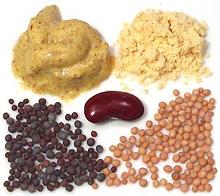 [White Mustard; Sinapis alba alt
Brassica alba, B. hirta | Black Mustard;
Brassica nigra | Brown Mustard, Indian Brown
Mustard, Leaf Mustard; Brassica juncea]
[White Mustard; Sinapis alba alt
Brassica alba, B. hirta | Black Mustard;
Brassica nigra | Brown Mustard, Indian Brown
Mustard, Leaf Mustard; Brassica juncea]
Mustard seeds come in three colors, white (actually yellow or tan),
black (actually a very dark brown), and brown. White mustard seed is
the norm in Europe and used to make prepared mustard (top left) and
powdered mustard (top right). Black mustard seed is preferred in India
where it is much used as a spice in cooking. Brown mustard seed is
grown in Russia for seed oil and to produce "Hot Russian Mustard". It
is also used to produce mustard greens in Russia and Asia. For more on
mustard seed see our page
Mustard Seed & Oil.
Canola Oil
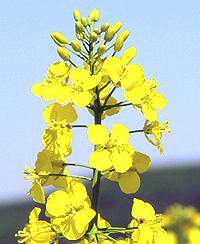 [Lear Oil, Brassica campestris]
[Lear Oil, Brassica campestris]
When Canada's market for rapeseed oil, used to lubricate steam machinery, faded away after World War II, they needed a new market, and chose "health food", a choice that had worked well for some other industrial products that needed a new market. The FDA wouldn't let it be sold in the United States due to a high content of erucic acid, so they developed a low erucic acid variety (originally by breeding - but now it's all genetically engineered) called "lear oil" (Low Erucic Acid Rapeseed Oil) which the FDA approved (there are rumors significant money changed hands to get the GRAS rating).
Lear Oil wasn't a sellable name, so it was re-named "Canola Oil", and
a huge marketing campaign was launched. This campaign was so successful
practically every recipe you read these days calls specifically for
Canola Oil. Some actual experts in edible oils are not at all confident
in the health safety of this oil. For details see our
Canola Oil page.
London Rocket - Teff
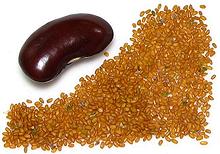 [Khakshir (Persian);Sisymbrium irio]
[Khakshir (Persian);Sisymbrium irio]
Caution: This is NOT the "Teff"
from which Injera bread is made in Ethiopia and Eritrea, even though it
looks a lot like it. This one is a Mustard Seed, not a Grain, and is used
in Persia (Iran) and Afghanistan in the making of Sharbat, a refreshing
cold soft drink, and as a medicinal. The dried leaves are used by the
Bedouin as a Tobacco substitute. It got the name "London Rocket"
because it grew so prolifically after the Great London Fire, and was also
found around bomb craters during the Blitz. The tiny seeds are about
0.001 inch wide (0.025 mm) and about 0.0015 inches long (0.038 mm).
Details and Cooking.
Mustard Seed Oil
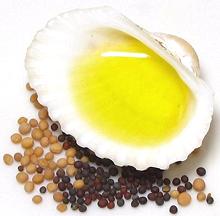 [White Mustard; Sinapis alba alt
Brassica alba, B. hirta | Black Mustard;
Brassica nigra | Brown Mustard, Indian Brown
Mustard, Leaf Mustard; Brassica juncea]
[White Mustard; Sinapis alba alt
Brassica alba, B. hirta | Black Mustard;
Brassica nigra | Brown Mustard, Indian Brown
Mustard, Leaf Mustard; Brassica juncea]
Mustard Oil is the traditional cooking oil of Bengal (West Bengal in
northeast India and Bangladesh) and is used for some types of frying
throughout northern India. It is considered essential for reproducing
the unique flavors of the regions where it is used. All mustard seed
oil sold in the United States is labeled "for massage use only" because
it lacks FDA approval. The reasons are now considered invalid, but
there's no money for an FDA reevaluation. I suppose you can use it for
massage (it might sting a bit) but nearly all is used for cooking.
For details see our
Mustard Seed Oil page.
Fendler's Bladderpod
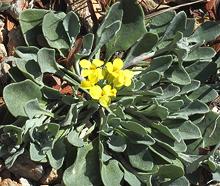 [Yellowtop, Lesquerella; Physaria fendleri]
[Yellowtop, Lesquerella; Physaria fendleri]
This plant, native to southwest United States and northern Mexico, is not
currently well known, but is increasingly in cultivation in its native
region. Development of improved varieties is in progress. The main
product is oil from its seeds. This oil is not used for cooking, but for
cosmetics and feedstock for industrial products, in place of much more
hazardous to produce castor oil. The seed coat, however, contains a gum
that may find use in foods in place of xanthan gum. The mash from oil
extraction is high in protein with an amino acid distribution similar to
soybeans, so may prove to be a useful animal fodder.
Photo by Russ Kleinman from
Western New
Mexico University Department of Natural Sciences and the Dale A.
Zimmerman Herbarium - © permission granted.


